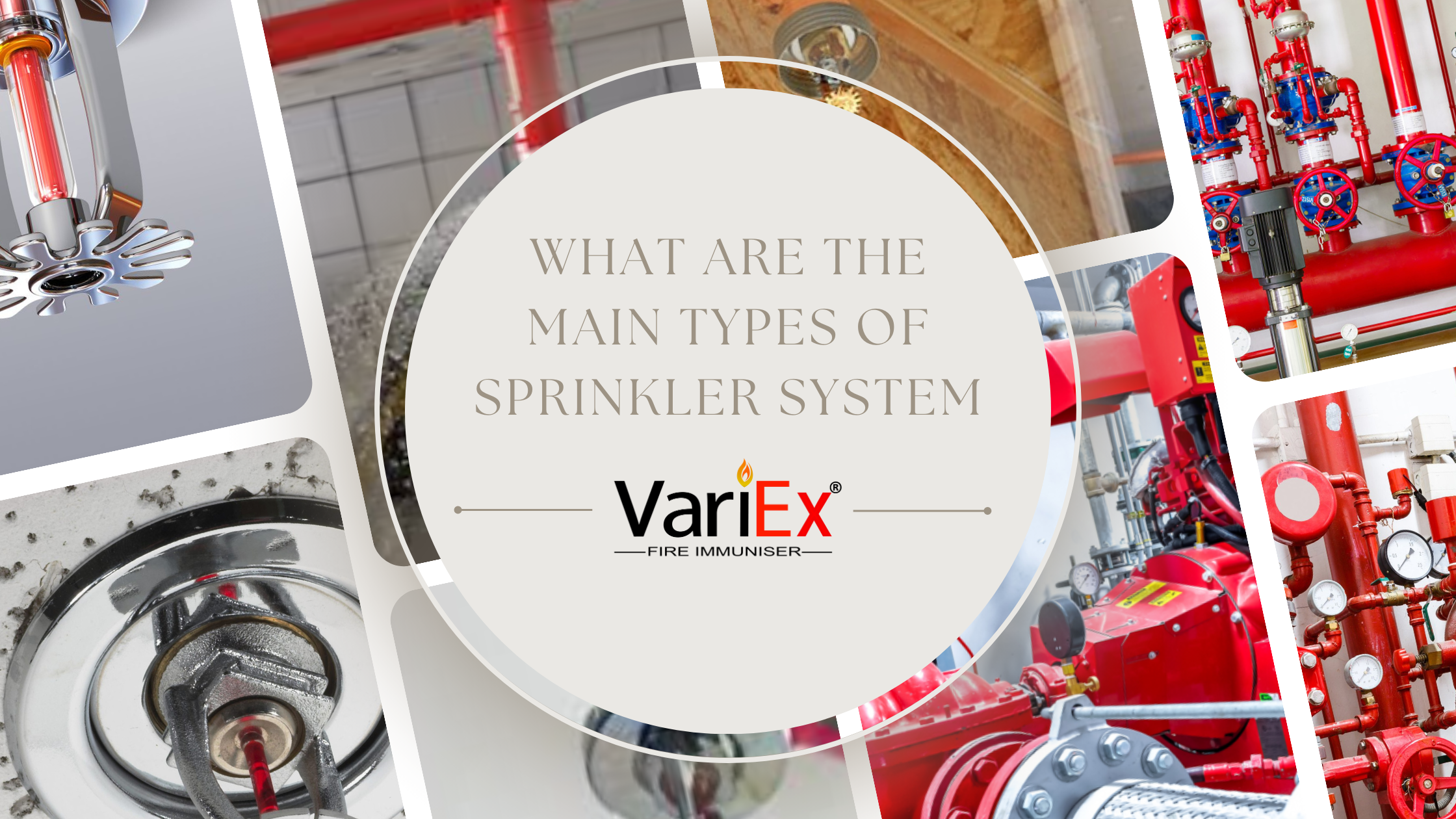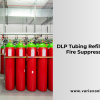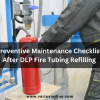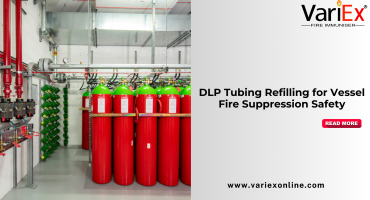![]()
Fire Immuniser
+91-7829629111
Email: info@variex.in
Varistor Technologies Pvt. Ltd.
Block-1, First Floor, Ardente Office One, Hoodi Circle, ITPL Main Road, Bengaluru, Karnataka 560048, IN
What Are The Main Types Of Sprinkler System
Sprinkler systems are vital components of fire protection systems, providing a reliable means of extinguishing or controlling fires in various environments. There are several types of sprinkler systems, each designed to suit different applications and requirements. Understanding these types can help individuals and businesses make informed decisions when it comes to fire safety measures. In this guide, we'll delve into the main types of sprinkler systems, their features, and their typical uses.
Wet Pipe Sprinkler Systems:
- Description: Wet pipe sprinkler systems are the most common type, featuring pipes filled with water under pressure.
- Operation: Water is immediately discharged when a sprinkler head detects heat, as the system is always filled with water.
- Application: Ideal for environments where freezing temperatures are not a concern, such as offices, residential buildings, and retail spaces.
Dry Pipe Sprinkler Systems:
- Description: Dry pipe systems are similar to wet pipe systems but contain pressurized air or nitrogen instead of water in the pipes.
- Operation: Water is held back by a valve, and when a sprinkler head activates due to heat, the valve releases, allowing water to flow into the piping system and out through the open sprinkler head.
- Application: Suitable for environments where freezing temperatures are a concern, such as unheated warehouses, parking garages, and outdoor areas.
Pre-Action Sprinkler Systems:
- Description: Pre-action systems are a combination of wet and dry pipe systems, featuring pipes filled with air or nitrogen and water held back by a pre-action valve.
- Operation: Activation of a smoke or heat detector triggers the pre-action valve to open, allowing water to flow into the piping system. Individual sprinkler heads then operate in response to heat, similar to wet pipe systems.
- Application: Ideal for environments with sensitive equipment or irreplaceable assets, such as data centers, museums, and libraries.
Deluge Sprinkler Systems:
- Description: Deluge systems differ from other types as all sprinkler heads are open, and the piping system is not pressurized until the deluge valve is activated.
- Operation: When a fire is detected, the deluge valve opens, releasing water to all sprinkler heads simultaneously.
- Application: Commonly used in high-hazard environments where rapid fire suppression is crucial, such as chemical storage facilities, aircraft hangars, and power plants.
Foam Sprinkler Systems:
- Description: Foam systems use a combination of foam concentrate and water to suppress fires involving flammable liquids or materials.
- Operation: When activated, foam concentrate mixes with water, creating a foam solution that is discharged through sprinkler heads.
- Application: Suitable for environments where flammable liquids are present, such as fuel storage areas, chemical processing plants, and industrial facilities.
Information On Their Components, Installation Considerations, Maintenance, and Benefits.
Components of a Sprinkler System:
- Control Panel: The control panel serves as the brain of the sprinkler system, monitoring inputs from detection devices and activating the system when necessary.
- Piping: Pipes distribute water or other extinguishing agents throughout the protected area, connecting to sprinkler heads.
- Sprinkler Heads: Sprinkler heads are the visible components of the system, typically mounted on ceilings or walls. They contain a heat-sensitive element that activates when exposed to high temperatures, releasing water or other agents to suppress the fire.
- Detection Devices: Smoke detectors, heat detectors, or flame detectors are used to detect the presence of fire and signal the control panel to initiate sprinkler operation.
- Valves: Various valves, including control valves, pre-action valves, deluge valves, and isolation valves, control the flow of water or extinguishing agents within the system.
Installation Considerations:
- Building Codes and Regulations: Sprinkler system installation must comply with local building codes and fire safety regulations, which may dictate system design, placement of sprinkler heads, and maintenance requirements.
- Hydraulic Calculations: Hydraulic calculations are performed to determine the water supply requirements, pipe sizes, and pressure levels necessary to effectively operate the sprinkler system.
- Zone Designation: Buildings may be divided into zones, each served by its own sprinkler system or section of a system, allowing for targeted fire protection and water conservation.
- Integration with Building Systems: Sprinkler systems may need to be integrated with other building systems, such as HVAC, to ensure optimal performance and coordination during fire events.
Maintenance:
- Regular Inspection: Sprinkler systems require regular inspections by qualified technicians to ensure all components are in proper working order and free from obstruction.
- Testing and Certification: Periodic testing and certification of sprinkler systems are necessary to verify their functionality and compliance with regulatory standards.
- Repairs and Upgrades: Prompt repair of damaged components and consideration of system upgrades, such as retrofitting older systems with newer technology, help maintain the effectiveness of sprinkler systems over time.
Benefits of Sprinkler Systems:
- Fire Protection: Sprinkler systems provide reliable fire protection, quickly suppressing fires and limiting their spread, which can save lives and reduce property damage.
- Property Protection: By containing fires in their early stages, sprinkler systems help minimize damage to buildings, equipment, inventory, and other assets.
- Insurance Premium Reduction: Many insurance companies offer premium discounts for properties equipped with sprinkler systems due to their proven effectiveness in reducing fire risk.
- Peace of Mind: Knowing that a reliable fire suppression system is in place provides peace of mind for building occupants, homeowners, and business owners, enhancing overall safety and security.
Sprinkler systems play a vital role in fire protection, offering a proactive approach to fire safety by quickly detecting and suppressing fires. By understanding the main types of sprinkler systems and their applications, individuals and businesses can implement the most suitable solution to safeguard lives, property, and assets against the devastating effects of fire.
Frequently Asked Questions
A sprinkler system is a fire protection system consisting of a network of pipes, valves, and sprinkler heads installed throughout a building. When a fire is detected by heat, smoke, or flame detectors, the sprinkler system activates, releasing water or other extinguishing agents through the sprinkler heads to suppress the fire.
The main types of sprinkler systems include wet pipe systems, dry pipe systems, pre-action systems, deluge systems, and foam systems. Each type has specific applications and features designed to address different fire hazards and environmental conditions.
Sprinkler systems are commonly installed in commercial buildings, industrial facilities, residential buildings, warehouses, healthcare facilities, and other structures where fire protection is essential. They may also be required by building codes and regulations in certain jurisdictions.
Yes, sprinkler systems are highly effective in suppressing fires, with studies showing that they can control or extinguish fires in the vast majority of cases. Properly designed, installed, and maintained sprinkler systems can significantly reduce the risk of fire-related injuries, fatalities, and property damage.
No, only the sprinkler heads in close proximity to the fire are activated. Each sprinkler head is individually activated by heat, typically at temperatures ranging from 135 to 165 degrees Fahrenheit, depending on the type of sprinkler head.
Final Say
At VariEx.in and VariexOnline.com, we specialize in supplying and installing top-quality fire fighting systems and equipment. From fire extinguishers to advanced suppression systems, we offer comprehensive solutions tailored to your needs. Our experienced team ensures precise installation and maintenance for optimal safety.
Trust VariEx for reliable fire protection. Contact us online or call 7829629111 to learn more.
"WHAT YOU CAN READ NEXT"
 Read more +24 November 2023 in Fire Extinguisher
Read more +24 November 2023 in Fire ExtinguisherWhat types of fire extinguishers are available for different fire classes?
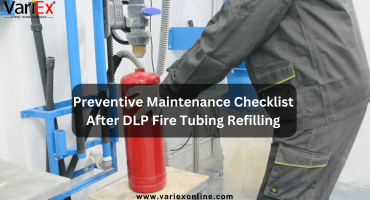 Read more +11 July 2025 in Fire Suppression
Read more +11 July 2025 in Fire Suppression

